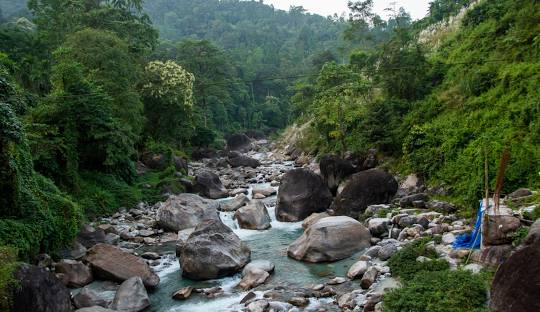Jaldhaka River
The Jaldhaka River is a vital waterway located in the northern part of India, which originates from the glaciers of the Eastern Himalayas in Bhutan and flows through the Indian state of West Bengal. The river is approximately 192 km long, and its basin covers an area of around 3,200 square km. The Jaldhaka River is known for its natural beauty, rich biodiversity, and cultural significance.
Origin and Course :
The Jaldhaka River originates from the Chumbi Valley in Bhutan and enters India through the Kalimpong district of West Bengal. The river flows in a southwesterly direction through the foothills of the Himalayas and passes through the towns of Jhalong, Bindu, Paren, and Samsing, before joining the river Teesta near Gajoldoba.
The Jaldhaka River basin comprises of several tributaries, such as the Neora, Chel, Rincheng, and Kali rivers. The river receives its water from the melting snow and ice from the Eastern Himalayas and the monsoon rains that occur during the months of June to September.
Geography and Ecology :
The Jaldhaka River flows through the Darjeeling district of West Bengal, which is known for its hilly terrain and lush green forests. The river basin is characterized by steep slopes, deep valleys, and thick forests, which provide habitat to a diverse range of flora and fauna.
The Jaldhaka River basin is home to several endangered species, such as the Indian elephant, clouded leopard, Himalayan black bear, and red panda. The river is also known for its fish diversity, with several species of fish, such as the mahseer, trout, and catfish, found in its waters.
The Jaldhaka River basin is rich in biodiversity and is recognized as an important bird area by BirdLife International. The region is home to several species of birds, such as the hornbill, thrush, and laughing thrush, which are found in the forests and along the river banks.
Culture and Economy :
The Jaldhaka River has significant cultural and economic importance for the people living in the region. The river is considered sacred by the local communities, and several religious and cultural festivals are celebrated along its banks.
The Jaldhaka River is also important for the agricultural economy of the region. The river basin is home to several tea gardens, which produce high-quality tea that is exported worldwide. The river provides irrigation water to the tea gardens and other agricultural fields in the region.
The Jaldhaka River is also a source of hydroelectric power for the region. Several hydropower projects have been set up on the river, which generate electricity for the local communities and the state of West Bengal.
Environmental Threats :
The Jaldhaka River and its basin are facing several environmental threats due to human activities. The increasing population, agricultural activities, and tourism have led to deforestation, soil erosion, and water pollution in the region.
The use of pesticides and fertilizers in agriculture has led to the contamination of the river, affecting the water quality and the aquatic ecosystem. The construction of hydropower projects and dams has also affected the natural flow of the river, causing downstream impacts on the ecology and the livelihoods of the people living in the region.
Conclusion :
The Jaldhaka River is a vital waterway in the northern part of India, which is known for its natural beauty, rich biodiversity, and cultural significance. The river and its basin face several environmental threats due to human activities, which need to be addressed to ensure the sustainability of the region.


Rongo's Retreat
Rongos retreat is a serene, adventurous place and hence a one stop destination that is set within the beautiful scenic beauty of Rongo. Design of the retreat is done in view of people who would like to find some refuge and be in contact with nature and so warm hospitality is coupled with local experience.
CONTACT
info@rongosriversidefarmstay.com
© 2025. All rights reserved.
+91-8016801565
